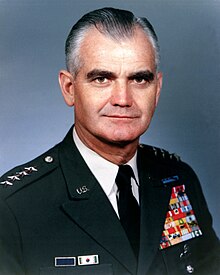William Childs Westmoreland
| William Westmoreland | |
|---|---|
 |
|
| Birth name | William Childs Westmoreland |
| Nickname(s) | "Westy" |
| Born |
March 26, 1914 Saxon, South Carolina, U.S. |
| Died | July 18, 2005 (aged 91) Charleston, South Carolina, U.S. |
| Buried | West Point Cemetery (United States Military Academy Post Cemetery) |
| Allegiance |
|
| Service/branch |
|
| Years of service | 1936–1972 |
| Rank |
|
| Commands held |
34th Field Artillery Battalion |
| Battles/wars |
World War II Korean War Vietnam War |
| Awards |
|
34th Field Artillery Battalion
504th Parachute Infantry Regiment
187th Regimental Combat Team
101st Airborne Division
Superintendent of the U.S. Military Academy
XVIII Airborne Corps
Military Assistance Command, Vietnam
William Childs Westmoreland (March 26, 1914 – July 18, 2005) was a United States Army general, who most notably commanded U.S. forces during the Vietnam War from 1964 to 1968. He served as Chief of Staff of the United States Army from 1968 to 1972.
Westmoreland adopted a strategy of attrition against the Viet Cong and the North Vietnamese Army, attempting to drain them of manpower and supplies. He also made use of the United States' edge in artillery and air power, both in tactical confrontations and in relentless strategic bombing of North Vietnam. Many of the battles in Vietnam were technically U.S. victories, with the U.S. Army in control of the field afterward; holding territory gained this way proved difficult, however. Public support for the war eventually diminished, especially after the Battle of Khe Sanh and the Tet Offensive in 1968. By the time he was re-assigned as Army Chief of Staff, U.S. military forces in Vietnam had reached a peak of 535,000. Westmoreland's strategy was ultimately politically unsuccessful. Growing U.S. casualties and the draft undermined U.S. support for the war while large-scale casualties among non-combatants weakened South Vietnamese support. This, however, failed to weaken North Vietnam's will to fight, and the Government of South Vietnam - a factor largely out of Westmoreland's control - never succeeded in establishing enough legitimacy to quell defections to the Viet Cong.
...
Wikipedia
